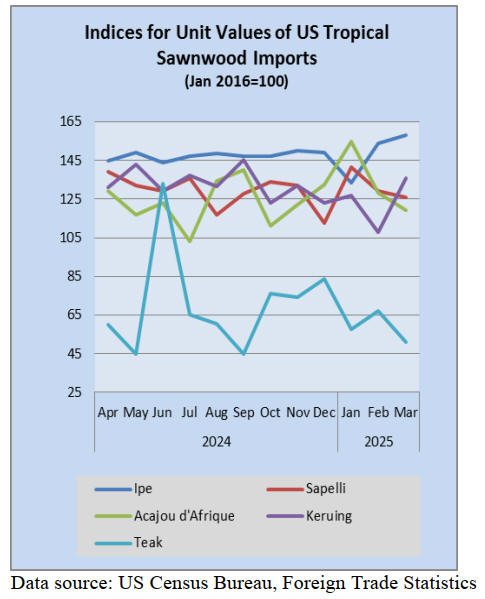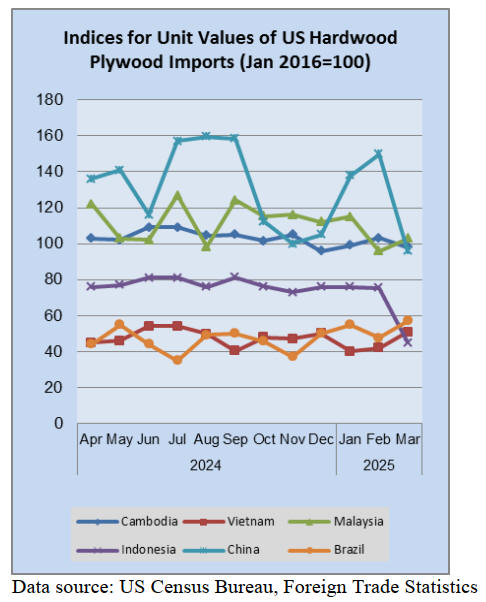|
Report from
North America
Housing starts tick up but single-family starts lag
US home building rebounded a little in April regaining
some of the ground lost in March,as the Trump
administration’s trade tariffs and their effect on building
materials hit the construction sector. Housing starts, a
gauge of new residential construction, rose 1.6% in April
to 1.36 million, according to the Commerce Department.
Single-family housing starts, which account for the bulk of
home building, dropped 2% to a seasonally adjusted
annual rate of 927,000 units in April, the lowest level
since July 2024. The Commerce Department also reported
that permits for future home construction fell sharply last
month. Permits for future construction of single-family
housing declined 5.1% to a rate of 922,000 units in April.
"Builders are hitting the brakes this year in response to
high uncertainty for costs and future demand," said Ben
Ayers, a senior economist at Nationwide. "In addition to
still-elevated mortgage rates, the building inventory within
the existing home market may weigh on homebuyer
interest in new builds.
This environment makes it risky for home builders to start
new projects, especially for time-consuming multi-family
structures. We expect starts to fade further over the
summer as conditions remain challenging for builder
profitability."
A National Association of Home Builders survey showed
sentiment among single-family home builders plunged to a
1-1/2-year low in May, with 78% of builders reporting
"difficulties pricing their homes recently due to
uncertainty around material prices."
Though the US and China have de-escalated their trade
war uncertainty remains over what happens after the 90-
day truce they agreed on. There is also no clarity on the
fate of country-specific duties which were delayed until
July.
In Canada, the annual pace of housing starts in April rose
30% compared with March. The Canadian national
housing agency says the seasonally adjusted annual rate of
housing starts for April was 278,606 units, up from
214,205 in March. That pace is 16% higher than that of
April 2024.
See: https://www.census.gov/construction/nrc/current/index.html
and
https://www.wsj.com/articles/u-s-housing-starts-ticked-up-in-
april-f37aea8c
Home sales drop to slowest April pace in 16 years
The spring housing market continues to struggle amid high
interest rates and low consumer confidence. Sales of
previously owned homes in April fell 0.5% from March to
a seasonally adjusted, annualised rate of 4 million units,
according to the National Association of Realtors.
That is the slowest April pace since 2009. Sales were
down 2% from April of last year. Housing economists
were expecting a gain of 2.7%.
"Home sales have been at 75% of normal or pre-pandemic
activity for the past three years, even with seven million
jobs added to the economy," said Lawrence Yun, NAR's
chief economist. "Pent-up housing demand continues to
grow, though not realised. Any meaningful decline in
mortgage rates will help release this demand."
Inventory jumped 9% month to month to a 4.4-month
supply and is now at its highest level in five years. But that
is still below the six-month supply which is considered a
balanced market.
In April, existing-home sales in the Northeast fell 2.0%
from March to an annual rate of 480,000, identical to April
2024.
In the Midwest, existing-home sales improved 2.1% in
April to an annual rate of 970,000, down 1.0% from the
prior year.
Existing-home sales in the South were unchanged from
March at an annual rate of 1.81 million in April, down
3.2% from one year before. And, in the West, existing-
home sales contracted 3.9% in April to an annual rate of
740,000, down 1.3% from a year ago.
See: https://www.nar.realtor/newsroom/existing-home-sales-
edged-lower-by-0-5-in-april
US economy contracted in Q1, first GDP pullback in 3
years
The US economy contracted for the first time in three
years to start 2025 as a surge in imports dragged down
GDP and prices increased more than forecast.
The Bureau of Economic Analysis' advance estimate of
first quarter US gross domestic product (GDP) showed
economic growth contracted at an annualized rate of 0.3%
during the year's first three months, more than the 0.2%
decline expected by economists surveyed by Bloomberg.
The reading came in significantly lower than the 2.4% rate
of growth seen in the fourth quarter of 2024. This marked
the first quarter of negative GDP growth since the first
quarter of 2022.
The decline was driven by a large surge in imports, which
are a subtraction in the calculation of GDP. Imports surged
at an annualized rate of 41.3% in the first quarter as
companies front-loaded orders ahead of anticipated tariffs
from the Trump administration.
"Trade was a huge influence," PNC Financial Services
Group chief economist Gus Faucher said. "We saw
companies bringing in a lot of imports to try to get ahead
of tariffs. We saw a huge build in inventories. But when
you look at underlying demand consumer spending
growth, that was still pretty solid."
See: https://www.bea.gov/news/2025/gross-domestic-product-
1st-quarter-2025-advance-estimate
US job market stays strong
US hiring remained sturdy in April as the economy added
177,000 jobs despite jitters over import tariffs and
widening federal government layoffs.
But payroll gains for February and March were revised
down sharply, at least partly offsetting the big jump last
month. So far this year, monthly job gains are averaging
143,000, down from 168,000 in 2024 but a solid figure
considering heightened uncertainty over the Trump
administration's economic policies and stock market
turmoil. Federal employment declined by 9,000 in a sign
that sweeping cuts by the Department of Government
Efficiency (DOGE) are starting to crimp the jobs numbers.
The manufacturing sector lost 1,000 jobs in April while
construction showed little or no change for the month.
See: https://www.bls.gov/news.release/empsit.nr0.htm
and
https://www.msn.com/en-us/money/markets/april-jobs-report-
employers-added-robust-177000-jobs-as-trumps-tariffs-kicked-
in/ar-AA1E2WnI?ocid=BingNewsVerp
Consumer confidence slumps as inflation worries rise
US consumer sentiment deteriorated further in May with
one-year inflation expectations soaring to levels last seen
in late 1981 amid escalating fears over the economic
impact of the President’s trade policy. The University of
Michigan's consumer sentiment index dropped to 50.8 this
month, the lowest level since June 2022, from a final
reading of 52.2 in April.
The survey showed a significant decline in morale among
Republicans, suggesting that even Trump's base was
becoming concerned with the president's sweeping tariffs
which led retail giant Walmart to warn that it would start
raising prices at the end of month because of increased
costs from import duties.
It was the first time that sentiment dropped among
Republicans since thes November election. The continued
slump in overall sentiment and jump in inflation
expectations suggested a retrenchment in consumer
spending was probably underway that could temper
economists' expectations for a rebound in economic
growth this quarter.
See: https://www.sca.isr.umich.edu/
US manufacturing slows - furniture and wood products
see largest decline
Economic activity in the US manufacturing sector
contracted for a second consecutive month in April,
according to the latest Manufacturing ISM Report on
Business by the Institute for Supply Management.The
Manufacturing Purchasing Managers’ Index (PMI)
registered 48.7%, down from 49% in March.
A reading below 50% indicates contraction. The April
figure reflects weakening demand, declining production,
and continued employment cutbacks across much of the
sector.
The Wood Products industry and the Furniture & Related
Products industry were cited as the two categories
reporting the largest contraction in April. Six of the 18
manufacturing industries surveyed by ISM reported
contraction in April while 11 industries, led by Apparel,
reported growth.
See: https://www.ismworld.org/supply-management-news-and-
reports/reports/ism-report-on-business/
Cabinet sales fell
Manufacturers reported an almost 5% drop in overall
cabinet sales for the first quarter of 2025 according to the
Kitchen Cabinet Manufacturers Association's March Trend
of Business report.
Sales totaled nearly US$580 million in January-March,
down from nearly US$610 million in sales for the same
period in 2024. Unit volume was down 14.5% for the
quarter, falling from 1.78 million units in Q1 2024 to 1.53
million units this year.
In March, total sales rose 12.5% from February’s sales but
were 4.0% short of sales for last March. Stock sales were
particularly slow, down 2.0% from the previous month
and 21% from March 2024.
See:
https://kcma.org/sites/default/files/styles/max_1300x1300/public/
2025-05/trend%20of%20business%20-
%20newsletter.jpg?itok=tMC4r_53


|